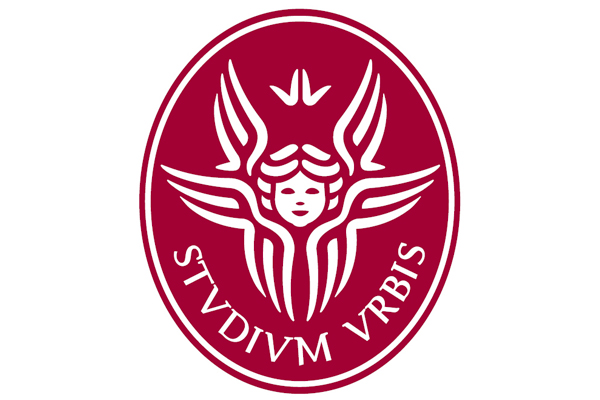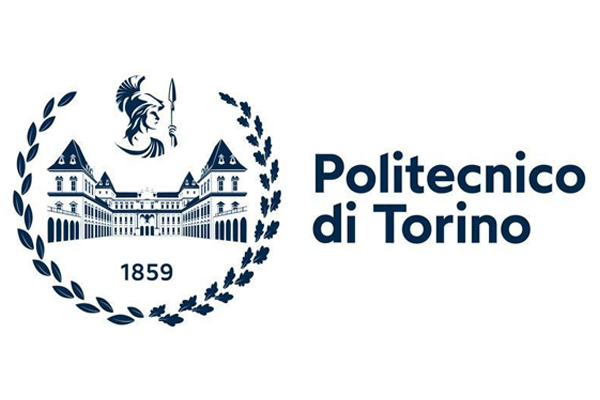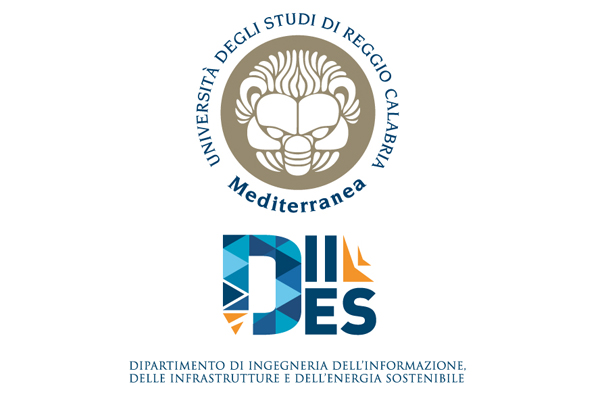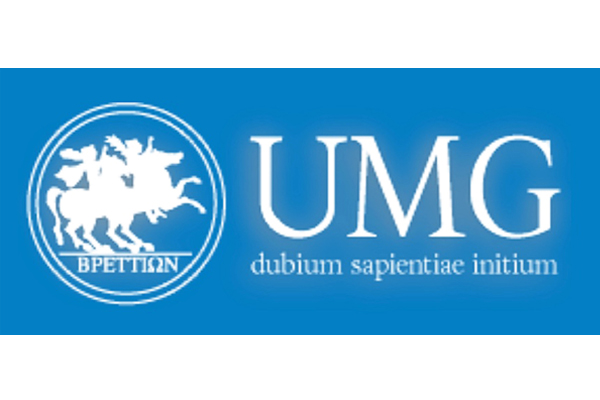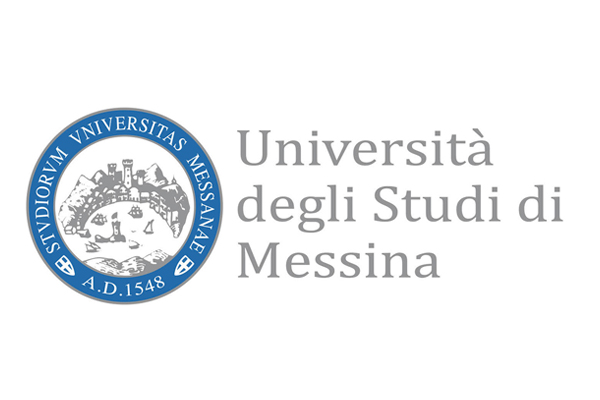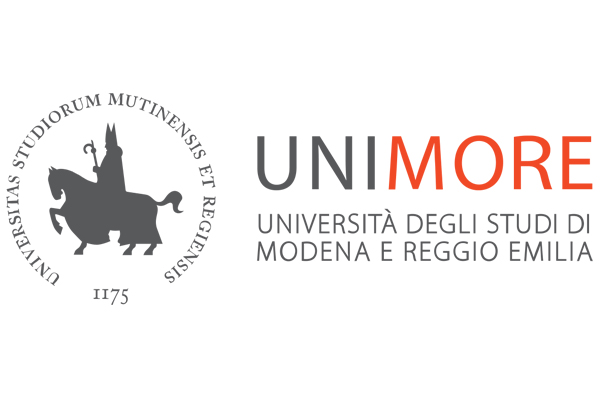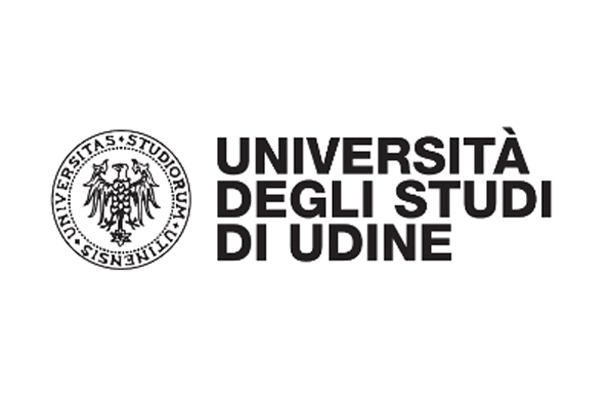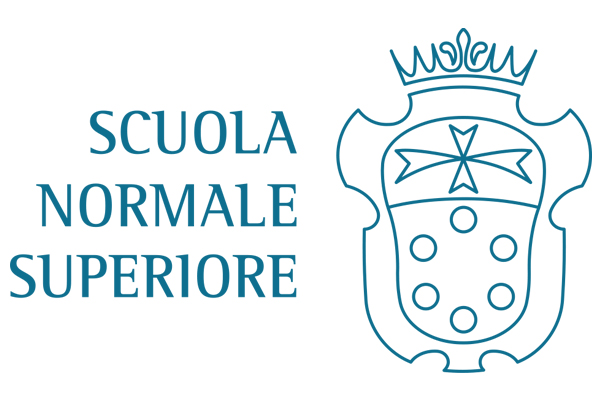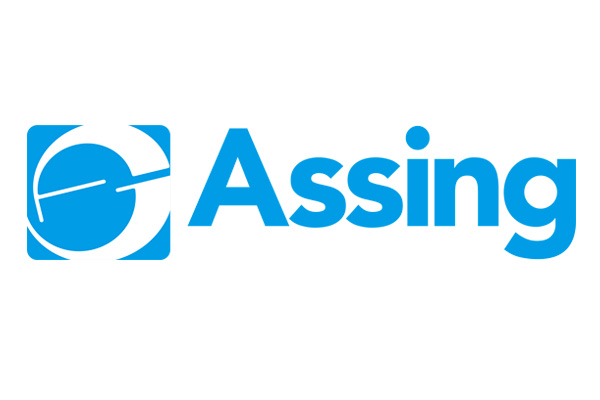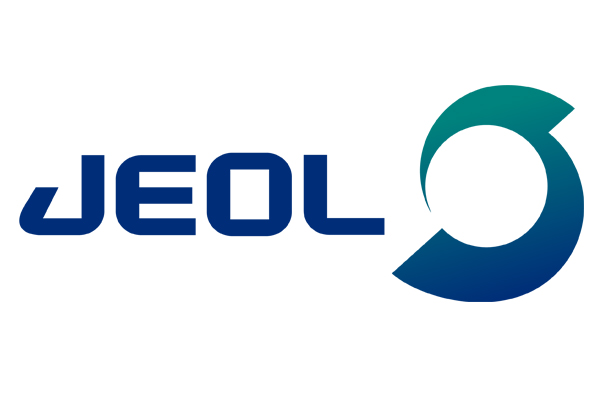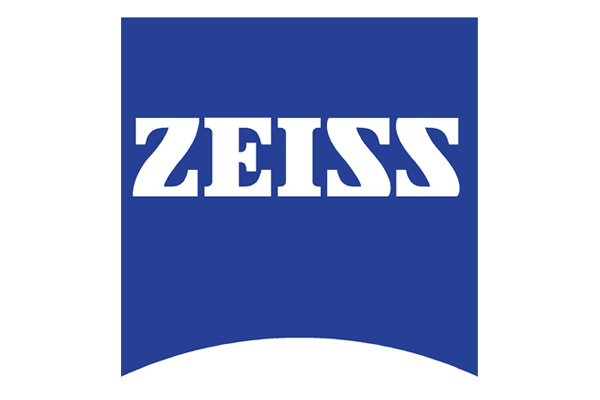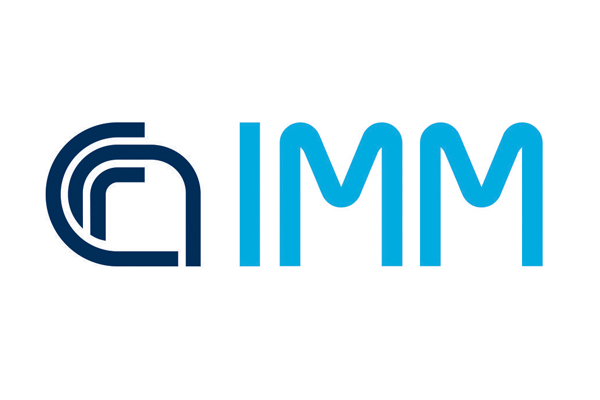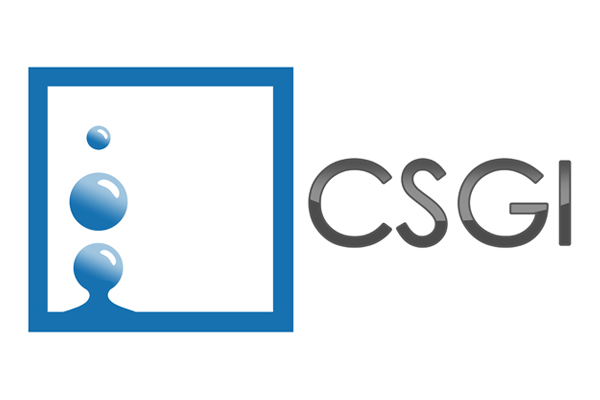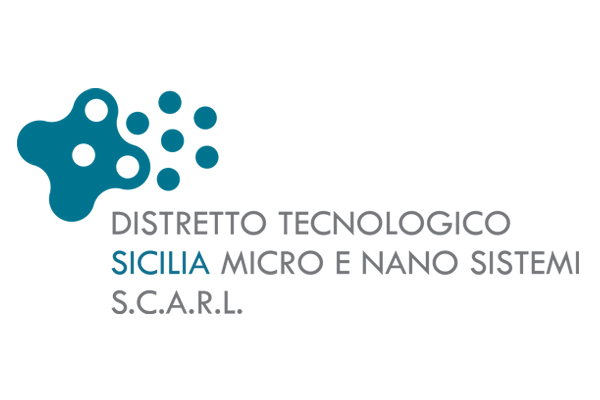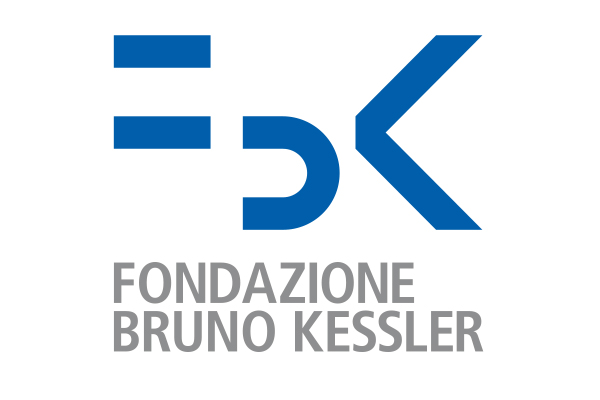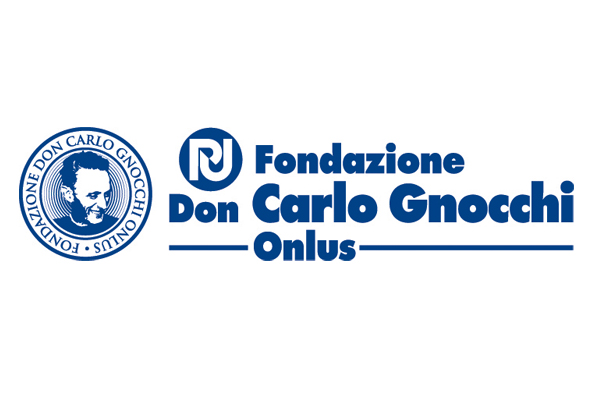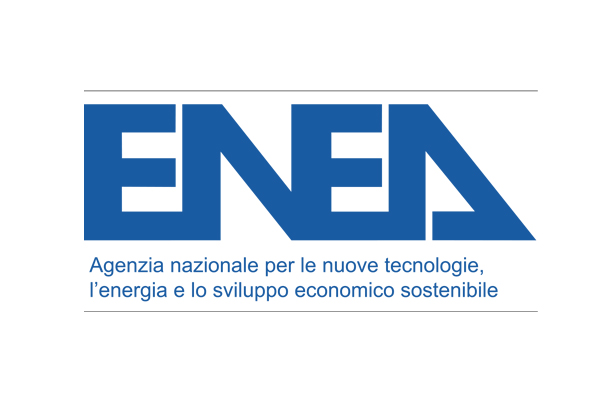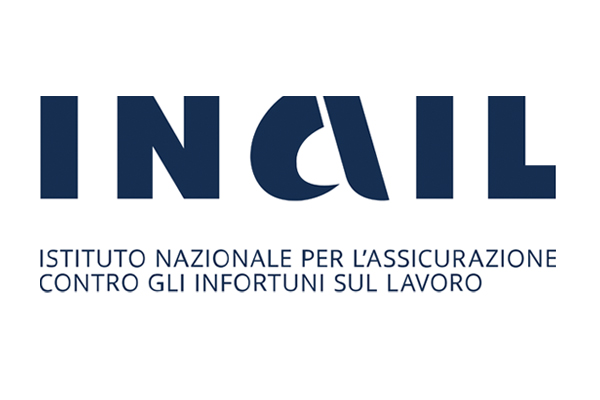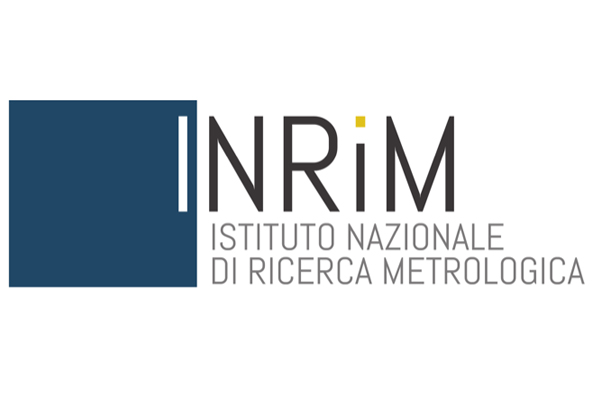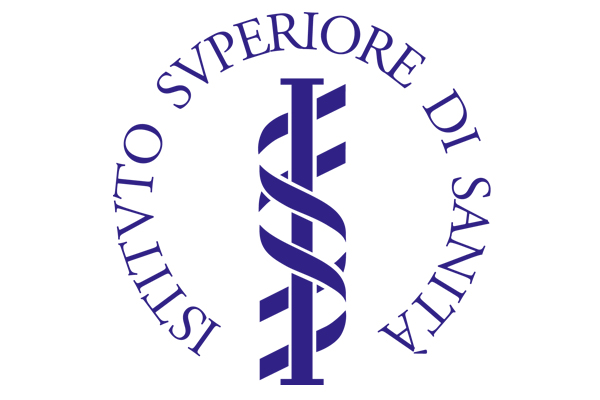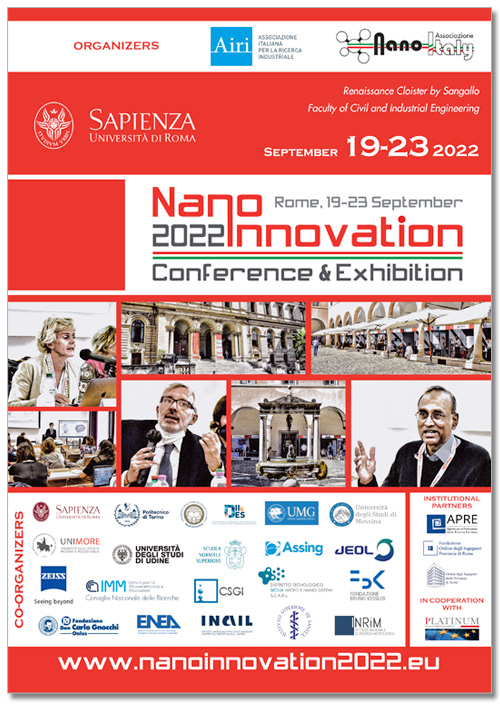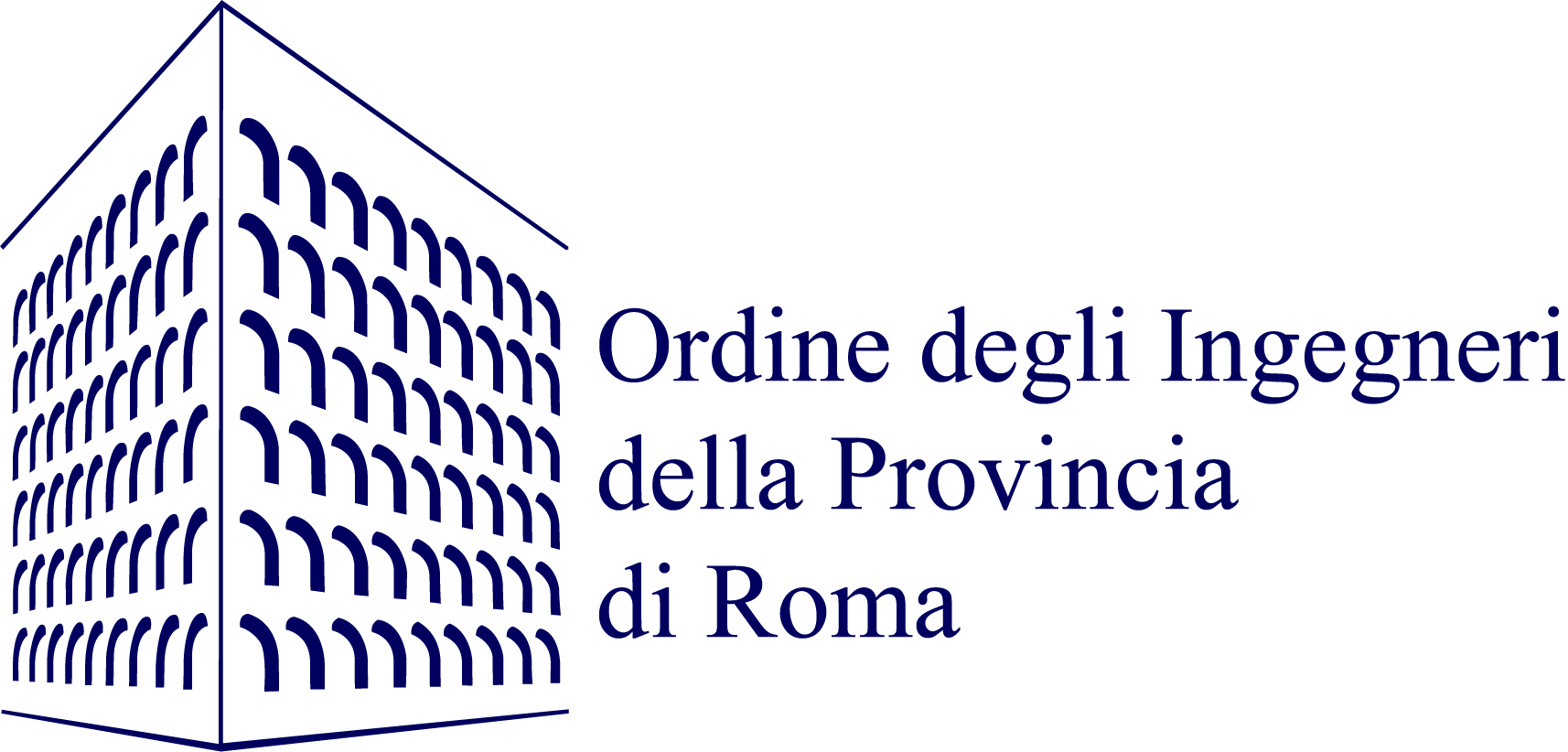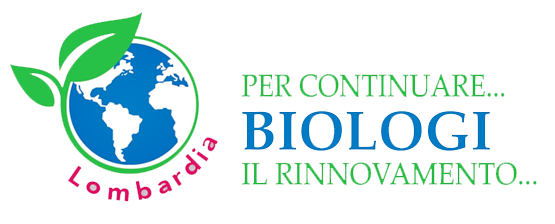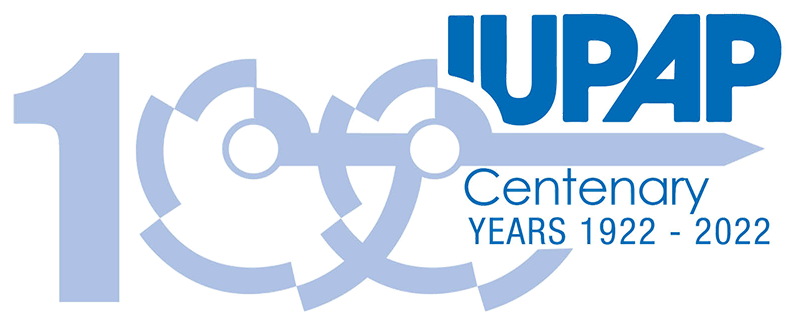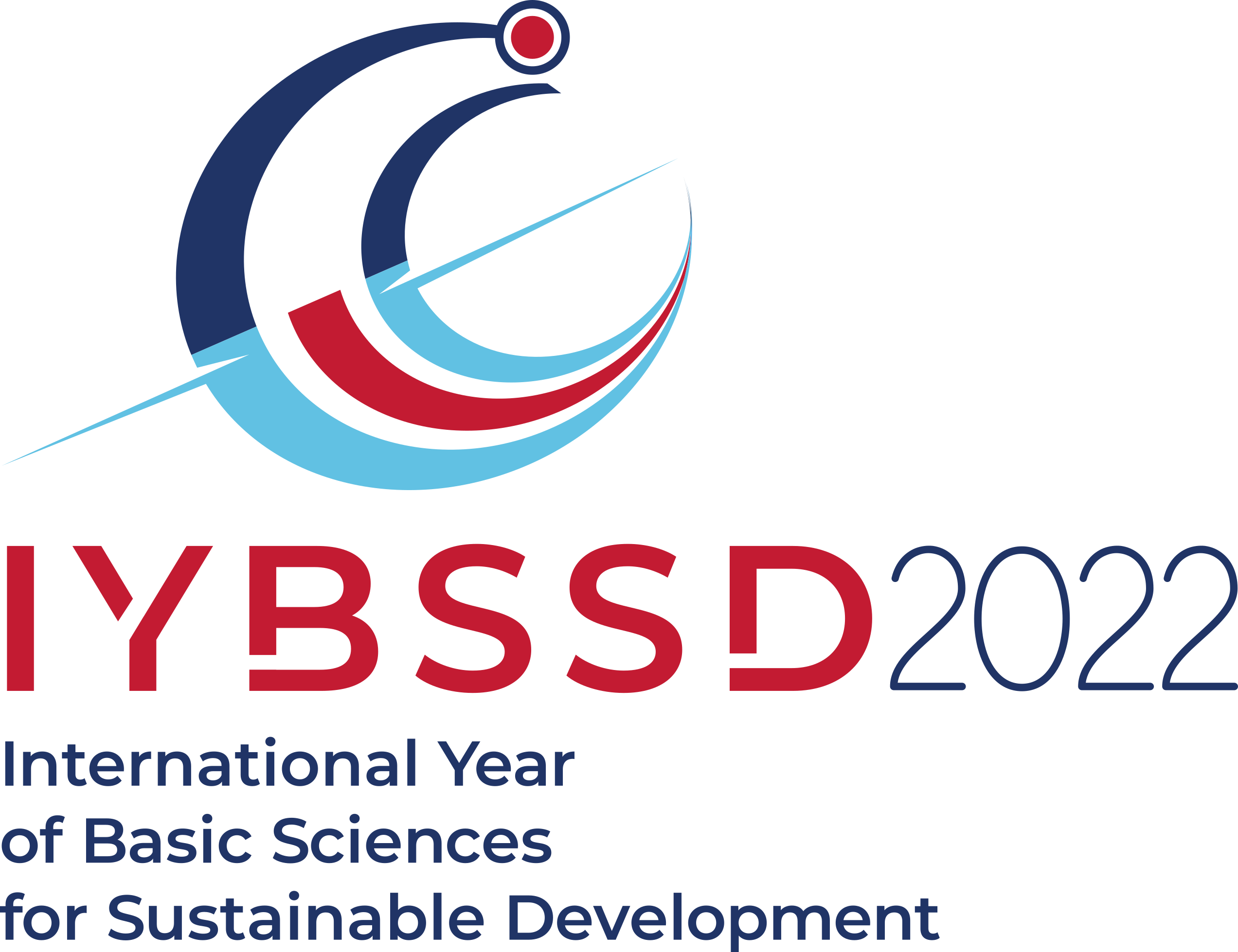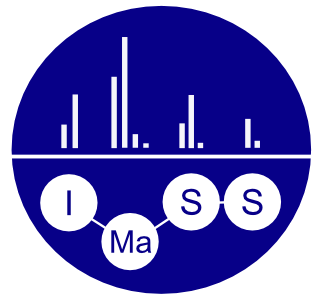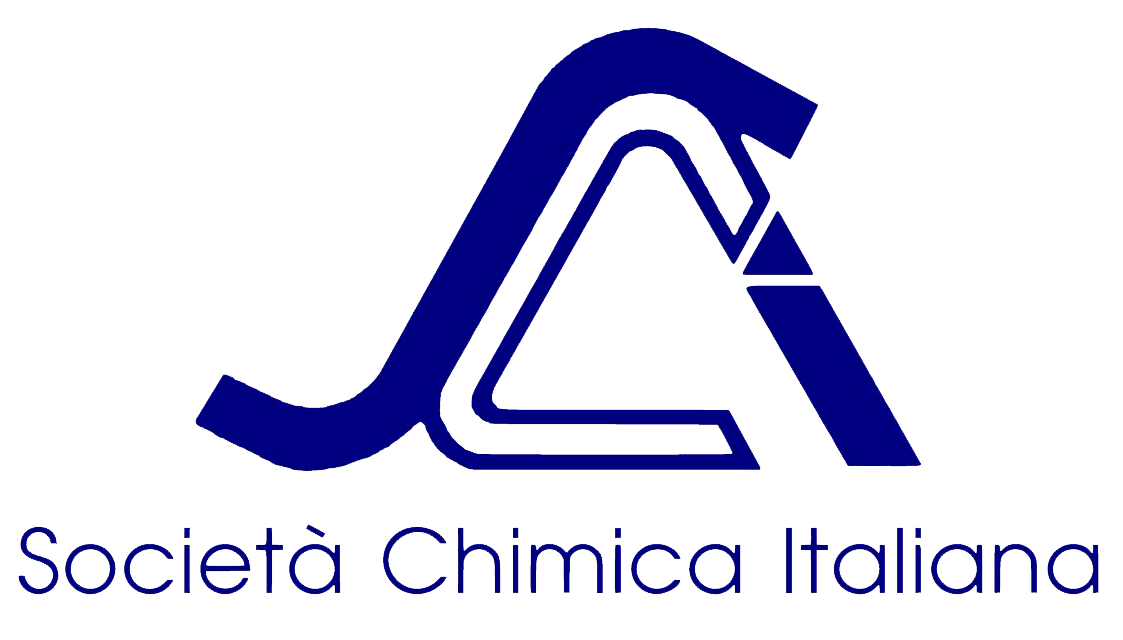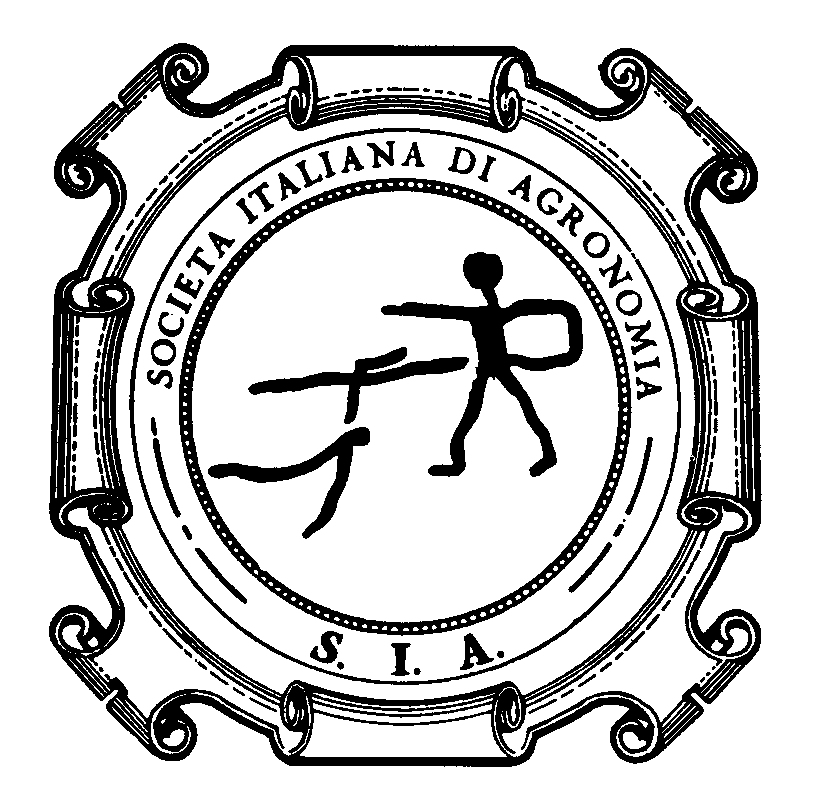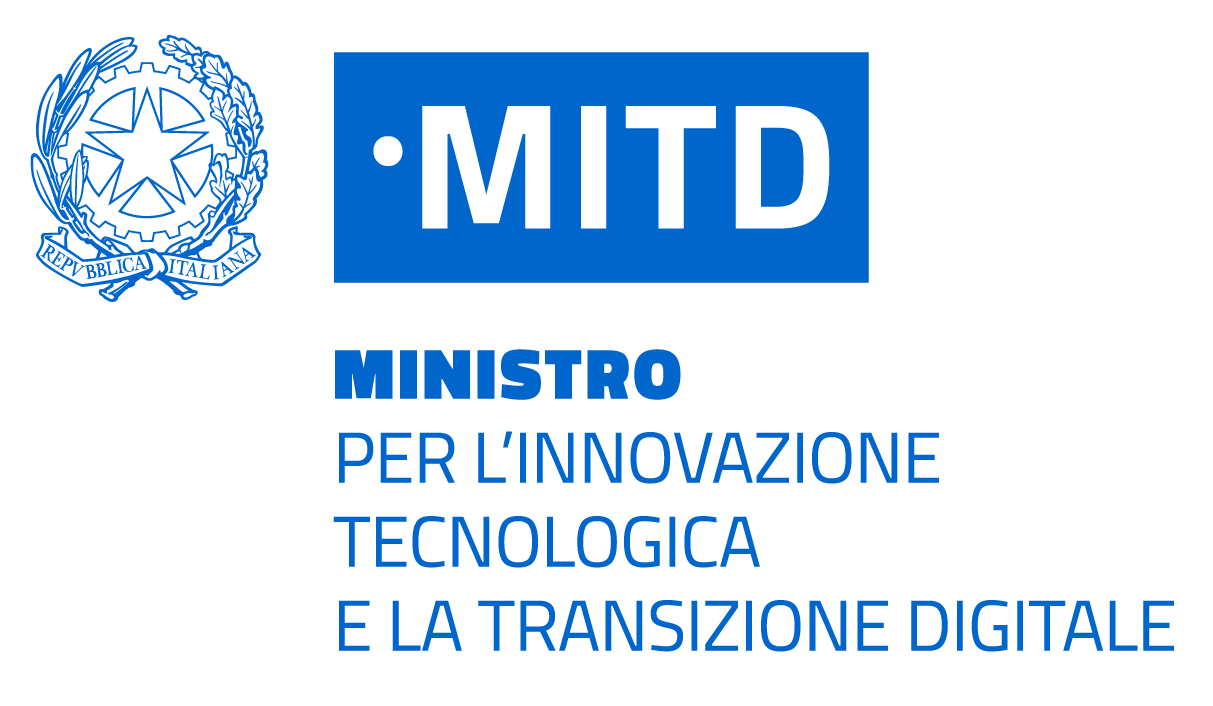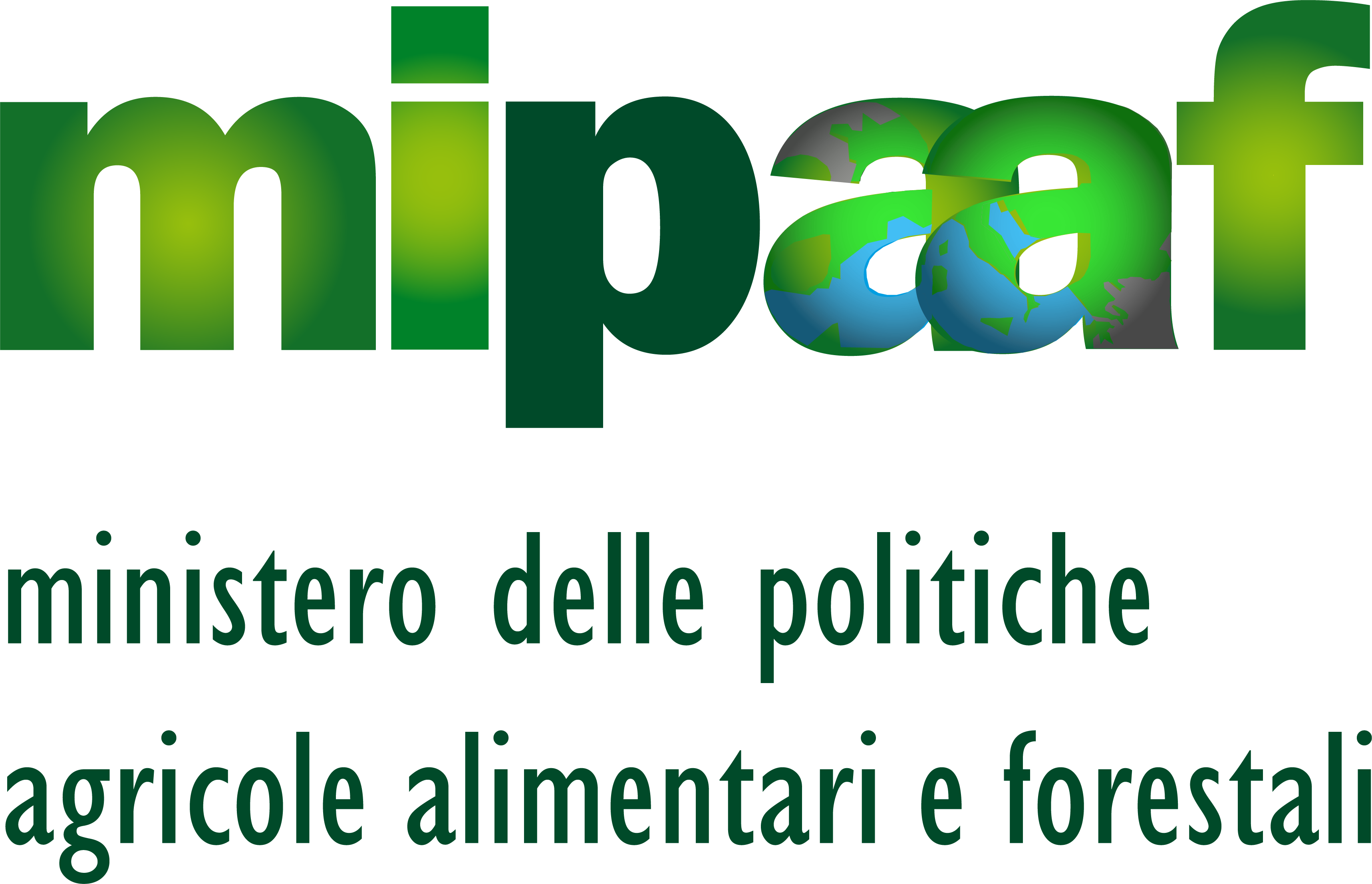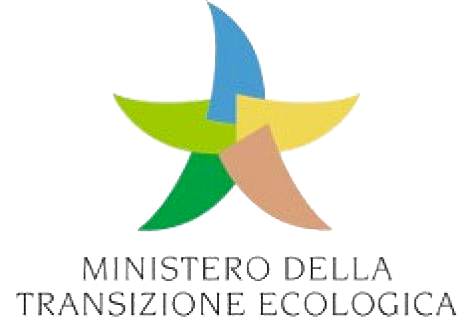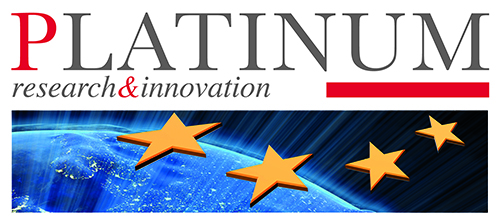Fields & Topics
NanoInnovation 2022 will focus in cross-cutting way on different topics, not necessarily related to micro-and nanotechnologies. The impact of technologies and innovations broadly speaking on science and production will revolutionise many sectors such as security, food safety and environmental technology. NanoInnovation 2022 will place special emphasis on different fields and topics: from nanomaterials and nano-devices to nano-biotechnology, from health and environmental/energy safety to ethics and 3D manufacturing.
In this page, you can discover all the topics that will be deepened during the conference and the related thematic symposia, workshops and special events.
Multi-track sessions with parallel thematic symposia are scheduled on September 21 - 22 - 23. Each of the twelve multi-track sessions will include at least 4 parallel thematic symposia, each of them of 90 minutes. Some thematic symposia are part of workshops and special events while others are organized independently.

Environment is a cross-cutting and interdisciplinary topic, related and depending to population growth, patterns of production, international trade and rapid technological progress. In this context, technology and green technology are playing an increasingly central role at European and global level. Green tech refers to a type of technology that is considered environmentally friendly based on its production process or its supply chain. The developments of this new way of seeing and conceiving technology offer significant opportunities for economic growth and societal well-being but nevertheless pose challenges and uncertainties. Furthermore, materials science plays a key role also in the development of energy applications and technologies, rising from generation to storage, conversion and distribution. Among this field, nanomaterials are extremely promising: their high aspect ratio and short diffusion pathways, combined with their compatibility with advanced manufacturing techniques, allow the design and production of highly efficient and easy to use energy devices. However, in order to have a real impact on everyday life, it is crucial to scale-up the synthetic processes, joining the laboratory issues with the market demand. During the conference, the following issues will be discussed:
| INNOVATION FOR THE ENERGY TRANSITION | TEMPORARY SCHEDULING |
|
Hydrogen as an energy vector for the future mobility |
Sept. 21 09:00 - 10:30 |
| The role of Hydrogen for the future energy system Co-organized with Polytechnic University of Turin, IIT Center for Sustainable Future Technologies - CSFT@POLITO and ENEA Chair: Elena TRESSO, Polytechnic University of Turin |
Sept. 21 11:30 - 13:00 |
| Batteries of the future: new generation of scientists sharing innovative ideas - Part 1 Co-organized with Polytechnic University of Turin, IIT Center for Sustainable Future Technologies - CSFT@POLITO and ENEA Chair: Margherita MORENO, ENEA |
Sept. 21 14:00 - 15:30 |
| Batteries of the future: new generation of scientists sharing innovative ideas - Part 2 Co-organized with Polytechnic University of Turin, IIT Center for Sustainable Future Technologies - CSFT@POLITO and ENEA Chair: Margherita MORENO, ENEA |
Sept. 21 16:00 - 17:30 |
| Nanomaterials and Nanotechnology for the virtuous CO2 circle - Part 1 Co-organized with Polytechnic University of Turin, IIT Center for Sustainable Future Technologies - CSFT@POLITO and ENEA Chair: Adriano SACCO, IIT Center for Sustainable Future Technologies - CSFT@POLITO |
Sept. 22 09:00 - 10:30 |
| Nanomaterials and Nanotechnology for the virtuous CO2 circle - Part 2 Co-organized with Polytechnic University of Turin, IIT Center for Sustainable Future Technologies - CSFT@POLITO and ENEA Chair: Michele RE FIORENTIN, IIT Center for Sustainable Future Technologies - CSFT@POLITO |
Sept. 22 11:30 - 13:00 |
| Advances in the field of carbon capture and storage technologies Co-organized with Polytechnic University of Turin, IIT Center for Sustainable Future Technologies - CSFT@POLITO and ENEA Chair: Stefano STENDARDO, ENEA |
Sept. 22 14:00 - 15:30 |
| The role of circular carbon for the future energy system Co-organized with Polytechnic University of Turin, IIT Center for Sustainable Future Technologies - CSFT@POLITO and ENEA Chair: Stefano STENDARDO, ENEA |
Sept. 22 16:00 - 17:30 |
| NANOMATERIALS FOR ENERGY | TEMPORARY SCHEDULING |
| A SWOT approach to Green Energy Innovation - Part 1 Co-organized with the European Innovation Council Chairs: Roberto GIANNANTONIO, Klopman International Srl & Francesco MATTEUCCI, European Innovation Council (EISMEA) |
Sept. 22 14:00 - 15:30 |
| A SWOT approach to Green Energy Innovation - Part 2 Co-organized with the European Innovation Council Chairs: Roberto GIANNANTONIO, Klopman International Srl & Francesco MATTEUCCI, European Innovation Council (EISMEA) |
Sept. 22 16:00 - 17:30 |
| Towards accelerated design of materials for energy Co-organized with ENEA Chairs: Francesco BUONOCORE & Massimo CELINO, ENEA |
Sept. 21 11:30 - 13:00 |
| Energy and charge transfer on surfaces and nanostructures - Part 1 Co-organized with University of Reggio Calabria & ENEA Chairs: Giuliana FAGGIO & Giacomo MESSINA, University of Reggio Calabria and Nicola LISI, ENEA |
Sept. 22 14:00 - 15:30 |
| Energy and charge transfer on surfaces and nanostructures - Part 2 Co-organized with University of Reggio Calabria & ENEA Chairs: Giuliana FAGGIO & Giacomo MESSINA, University of Reggio Calabria and Nicola LISI, ENEA |
Sept. 22 16:00 - 17:30 |

With the world’s population expected to exceed nine billion by 2050, scientists are working to develop new ways to meet rising global demand for food, energy and water without increasing the strain on natural resources and the environmental pressure. Organizations including the World Bank, and the U.N. Food and Agriculture Organization, as well as the EU F2F and Green Deal strategies are calling for more innovation to address the challenges of the agri-food sector. The development of AgriNanoTechniques has been started very recently; they will be implemented within the evolving science of precision agriculture, in which farmers use technology to target their use of water, fertilizer, plant protection products and other inputs. A second, broad potential application concerns the issues of reduction and valorization of agri-food wastes. The introduction of nanotechnologies in agriculture still need deepen basic and applied knowledge, however several promising results were achieved, so far. A huge development is taking place in this sector, therefore nanotech applications currently under development will soon be overtaken by other ideas that are expected to contribute to solve several issues in the field of sustainable agriculture. NanoInnovation 2022 hosts the 6th edition of the workshop “AgriNanoTechniques” co-organized by the Universities of Tuscia, Udine and the Italian National Institute of Health (ISS). The workshop will be the forum for discussing the perspective of nanotechnologies in the primary sector among the stakeholders and scientific research.
| AGRINANO TECHNIQUES | TEMPORARY SCHEDULING |
| Nanotechnology-based Innovative Approaches in Agriculture - Part 1 Co-organized with University of Tuscia, Udine and ISS Chair: Guido FELLET, University of Udine |
Sept. 23 09:00 - 10:30 |
| Nanotechnology-based Innovative Approaches in Agriculture - Part 2 Co-organized with University of Tuscia, Udine and ISS Chair: Guido FELLET, University of Udine |
Sept. 23 11:30 - 13:00 |

Health is a very wide field. The link between health and technology is very complex and is evolving rapidly and continuously due to numerous discoveries in both fields. This can depend on the application of organized knowledge and skills in the form of devices, medicines, procedures and systems developed to solve a health problem and improve quality of lives. During NanoInnovation 2022, we will focus on the most recent advances in these fields ranging from biomedical engineering, diagnostic and therapeutic procedures, monitoring devices and much more.
| NANOMEDICINE | TEMPORARY SCHEDULING |
| Innovative approaches in UNMET clinical needs for maximum health care impact - Part 1 Co-organized with Don Gnocchi Foundation, University of Modena and Reggio Emilia and University Magna Graecia of Catanzaro Chair: Marzia BEDONI, Don Gnocchi Foundation, Giovanni TOSI, University of Modena and Reggio Emilia & Donatella PAOLINO, University Magna Graecia of Catanzaro |
Sept. 21 09:00 - 10:30 |
| Innovative approaches in UNMET clinical needs for maximum health care impact - Part 2 Co-organized with Don Gnocchi Foundation, University of Modena and Reggio Emilia and University Magna Graecia of Catanzaro Chairs: Marzia BEDONI, Don Gnocchi Foundation, Giovanni TOSI, University of Modena and Reggio Emilia & Donatella PAOLINO, University Magna Graecia of Catanzaro |
Sept. 21 11:30 - 13:00 |
| Innovative approaches in UNMET clinical needs for maximum health care impact - Part 3 Co-organized with Don Gnocchi Foundation, University of Modena and Reggio Emilia and University Magna Graecia of Catanzaro Chairs: Marzia BEDONI, Don Gnocchi Foundation, Giovanni TOSI, University of Modena and Reggio Emilia & Donatella PAOLINO, University Magna Graecia of Catanzaro |
Sept. 21 14:00 - 15:30 |
| From artificial intelligence research to new scientific discoveries in biomedicine and vice versa Co-organized with ISS Chairs: Marco CRESCENZI & Irene RUSPANTINI, ISS |
Sept. 22 14:00 - 15:30 |
| Nano-based drug delivery systems: recent developments and preclinical studies for biomedical applications Co-organized with ISS Chairs: Marisa COLONE & Maria CONDELLO, ISS |
Sept. 22 11:30 - 13:00 |
| Nanomedicine: what can European initiatives do to accelerate your clinical development? Co-organized with the European Technology Platform on Nanomedicine (ETPN) Chair: Alexandre CECCALDI, ETPN |
Sept. 23 09:00 - 10:30 |
| NANO-BIO TECHNOLOGY |
TEMPORARY SCHEDULING |
| Extracellular vesicles: The new era of the intercellular communication - Isolation and characterization of EVs Co-organized with Sapienza University of Rome Chairs: Luciana DINI, Sapienza University of Rome & Stefano TACCONI, Sapienza University of Rome & NanoShare Srl |
Sept. 21 09:00 - 10:30 |
| Extracellular vesicles: The new era of the intercellular communication - EVs in diseases Co-organized with Sapienza University of Rome Chairs: Anna Maria GIUDETTI, University of Salento & Stefania MESCHINI, ISS |
Sept. 21 11:30 - 13:00 |
| Extracellular vesicles: The new era of the intercellular communication - PhD- derived EVs: implementing communication Co-organized with EVIta and Sapienza University of Rome Chairs: Annalisa RADEGHIERI, University of Brescia & Massimo BOTTINI, University of Rome Tor Vergata |
Sept. 21 14:00 - 15:30 |
| MICRO AND NANOTECHNOLOGIES IN EMERGING LIQUID BIOPSY APPLICATIONS |
TEMPORARY SCHEDULING |
| Organic transistors-based biosensors Co-organized with Polytechnic University of Turin Chairs: Matteo COCUZZA, Polytechnic University of Turin & Simone MARASSO, CNR-IMEM |
Sept. 22 09:00 - 10:30 |
| SERS and Nanophotonics Co-organized with Polytechnic University of Turin Chairs: Laura FABRIS & Enzo DI FABRIZIO, Polytechnic University of Turin |
Sept. 22 11:30 - 13:00 |
| LIFE SCIENCE & INNOVATIVE MATERIALS |
TEMPORARY SCHEDULING |
| Wearable Devices: The New Frontier of Medical Care Co-organized with Distretto Tecnologico Sicilia Micro e Nano Sistemi Chairs: Sabrina CONOCI, University of Messina & Pietro Aleardo SICILIANO, CNR-IMM, Lecce |
Sept. 21 16:00 - 17:30 |
| Organoid Experiment Analysis: From Image to Numerical Results Co-organized with ZEISS Chair: Francesco BIANCARDI, ZEISS |
Sept. 22 09:00 - 10:30 |

Developing, designing, producing and using micro- and nano electronics technologies is an enabling factor for any company willing to exploit the opportunities offered by the digital transformation. The conference will present an overview of the current state of the art of micro- and nanoelectronics, covering the field from fundamental science and material properties to novel ways of making nanodevices. As one of the key enabling technologies (KET), micro– nanoelectronics are one of the most interesting topic in the field of nanotechnology.
| MICRO-NANO ELECTRONICS | TEMPORARY SCHEDULING |
| The contribution of GaN4AP project for power conversion in smart mobility and energy consumption Co-organized with Distretto Tecnologico Sicilia Micro e Nano Sistemi Chair: Leoluca LIGGIO, GaN4AP & Distretto Tecnologico Sicilia Micro e Nano Sistemi |
Sept. 21 09:00 - 10:30 |
| IPCEI Microelectronics initiative: Tech solutions for the digital transformation, IoT and Industry 4.0 Co-organized with AIRI, FBK and STMicroelectronics Chairs: Andrea PORCARI, AIRI & Cosimo MUSCA, STMicroelectronics |
Sept. 22 11:30 - 13:00 |
| Emerging and advanced techologies in Electronics - Part 1 Co-organized with Sapienza University of Rome Chair: Roberto BEZ, Micron |
Sept. 22 09:00 - 10:30 |
| Industrial strategies and research policies toward Electronics Technology Co-organized with Sapienza University of Rome Chair: Marco Balucani, Sapienza |
Sept. 22 14:00 - 15:30 |
| Emerging and advanced techologies in Electronics - Part 2 Co-organized with Sapienza University of Rome Chair: Vittorio MORANDI, CNR-IMM |
Sept. 22 16:00 - 17:30 |
| SAFE AND SUSTAINABLE NANOMATERIALS | TEMPORARY SCHEDULING |
| Beyond state of the art, through Safe and Sustainable Development approaches for materials development - Practical implementation of Safe and Sustainable by Design approaches in applied and industrial research Co-organized with AIRI, ISS, FBK, INAIL and Gov4Nano project Chairs: Andrea PORCARI, AIRI & Gov4Nano and Lorenzo CALABRI, Art-er & Sbd4Nano |
Sept. 21 14:00 - 15:30 |
| Beyond state of the art, through Safe and Sustainable Development approaches for materials development - Strategies, frameworks and criteria for Safe and Sustainable Development Co-organized with AIRI, ISS, FBK, INAIL and Gov4Nano project Chair: Isabella DE ANGELIS, ISS |
Sept. 21 16:30 - 17:30 |

The exponential growth of nanotechnologies in recent years has required rapid development of nanoscience and in particular of microscopy and characterization techniques. Understanding these topics has become a fascinating field of research in continuous evolution. Moreover, a remarkable feature of these issues lies in its multidisciplinary nature as it finds application in physics, chemistry and biology. During the conference we will deepen all the following themes:
| RESEARCH MICROSCOPY AND CHARACTERIZATION | TEMPORARY SCHEDULING |
| Infrared microscopy with nanometric spatial resolution Co-organized with Sapienza University of Rome Chair: Stefano LUPI, Sapienza University of Rome |
Sept. 21 16:00 - 17:30 |
| IMAGE ANALYSIS | TEMPORARY SCHEDULING |
| ARTES4.0@SNS: the competences of the Macronode Scuola Normale Superiore in the field I4.0 Co-organized with Scuola Normale Superiore Chair: Pasqualantonio PINGUE, Scuola Normale Superiore |
Sept. 22 09:00 - 10:30 |

Quantum technology is an emerging field of physics and engineering, which relies on the principles of quantum physics. Nanofabrication and material engineering on the nanoscale plays a crucial role in many of the emerging fields in quantum technology like secure communication, biomedical imaging, ultrasensitive sensors or quantum computing. Bringing these technologies out of the research laboratories to real world applications requires still a tremendous effort also in the fields of material engineering and optimisation of devices and components applied. Many quantum technologies are based on the generation, manipulation and measurements of few or even single photons with well-defined and engineered optical properties. During the conference we will deepen all the following themes:
| QUANTUM METROLOGY | TEMPORARY SCHEDULING |
| Quantum Metrology and Technologies - Part 1 Co-organized with INRIM Chairs: Luca BOARINO & Natascia DE LEO, INRIM |
Sept. 23 09:00 - 10:30 |
| Quantum Metrology and Technologies - Part 2 Co-organized with INRIM Chairs: Luca BOARINO & Natascia DE LEO, INRIM |
Sept. 23 11:30 - 13:00 |

3D printing is the construction of a three-dimensional object from a CAD model or a digital 3D model. The term "3D printing" can refer to a variety of processes in which material is deposited, joined or solidified under computer control to create a three-dimensional object, with material being added together (such as plastics, liquids or powder grains being fused together), typically layer by layer. This year, this topic will receive a wide attention during the conference, as it has become increasingly innovative.
| 3D PRINTING AND HEALTH | TEMPORARY SCHEDULING |
| 3D printing for advanced healthcare: from life sciences to innovative materialS - Part 1 Co-organized with Polytechnic University of Turin Chairs: Francesca FRASCELLA, Lucia NAPIONE & Ignazio ROPPOLO, Polytechnic University of Turin |
Sept. 23 09:00 - 10:30 |
| 3D printing for advanced healthcare: from life sciences to innovative materialS - Part 2 Co-organized with Polytechnic University of Turin Chairs: Francesca FRASCELLA, Lucia NAPIONE & Ignazio ROPPOLO, Polytechnic University of Turin |
Sept. 23 11:30 - 13:00 |

The application of nanosciences and nanotechnologies and the preparation of new nanostructured or monofunctional materials and molecular, supramolecular or nanometric devices for diagnostics, conservation, monitoring and maintenance of cultural heritage with different types of matter (paintings on canvas / table, paintings murals, glass, ceramics, stone material, etc.) have been the subject of an intense scientific study by many universities and research centres. During the conference we will deepen the following themes:
| NANOMATERIALS FOR RESTORATION |
TEMPORARY SCHEDULING |
| Novel nanomaterials for restoration of artworks: from the lab to the bench Co-organized with CSGI Chair: Rodorico GIORGI, CSGI & University of Florence |
Sept. 22 11:30 - 13:00 |
| Key Enabling Technologies for the protection of cultural heritage: from earthquakes to big data - Part 1 Co-organized with CdE DTC Lazio Chair: Maria Sabrina SARTO, Sapienza University of Rome |
Sept. 22 14:00 - 15:30 |
| Key Enabling Technologies for the protection of cultural heritage: from earthquakes to big data - Part 2 Co-organized with CdE DTC Lazio Chair: Maria Sabrina SARTO, Sapienza University of Rome |
Sept. 22 16:00 - 17:30 |

Aerospace is definitely one of the fields where the impact of innovation is the most important. This is the direct consequence of the need for excellence related to the extreme conditions of operation, the very demanding specifications, the complexity of the equipment and the need for high level of reliability (very low rates of failure). In this section we will present and discuss two of the key technologies for the so-called “: New Space”: a) the use of COTS (components on the shelf) in electronic systems for space applications; b) the extensive use of metallic parts made by additive manufacturing for aerospace.
The New Space denomination indicates a change of paradigm within the business model of the space industry, characterised by a continued democratisation of space technology. This is mainly achieved with a constant decrease of the cost of the launching and of the satellite constellations and a consequent growing need for components with novel functionalities at lower costs. In this configuration the interest for COTS, i.e. components that are not especially conceived to operate in harsh radiative environments (RadHard), is growing considerably. As a consequence, the fact of properly characterising and understanding the limitations and the performance of standard components in a radiation environment gains momentum, with respect to the intention to design specific components dedicated for space. In this kind of perspective, the development of novel testing methodologies and the possibility to have access to opportune nuclear physics facilities to carry on some testing campaigns become strategic. A complete picture around this topic will be provided in the first part of the workshop.
Complementary to the aspects related to embedded electronics, the advanced manufacturing is another topic of primary importance for the future of the race for space. In this respect, Additive Manufacturing (AM) is the absolute game changer. AM offers the possibility to obtain unique shapes that can implement outstanding mechanical performances with reduced weight. Furthermore, AM is ideal when small series of pieces with very high added value are conceived, and when a continuous product development is envisaged. For these reasons, the second part of the workshop will be dedicated to the AM of metallic parts. The challenges related with the manufacturing will be discussed, but also the characterisation methodologies.
| NEW SPACE |
TEMPORARY SCHEDULING |
| Advances in electronic components: Unconventional radiation hardness characterisation and novel detectors Co-organized with ASI & ESRF Chair: Marco DI CLEMENTE, ASI |
Sept. 23 09:00 - 10:30 |
| Advances in manufacturing, materials and characterisation Co-organized with ASI & ESRF Chair: Marco SEBASTIANI, Roma Tre University |
Sept. 23 11:30 - 13:00 |

Innovative technologies, including nanotechnologies, represent, in recent decades, an important opportunity to improve human living conditions especially in healthy fields and materials sciences. The focus of this special event is to evaluate the current status of the research. In particular, we’ll analyze both very innovative aspects, with a particular focus on personalized medicine, microscopy techniques (AFM, TERS, SERS), micro and nanoelectronics, nanotechnology, advanced materials, photonics, advanced manufacturing and quantum technologies, and traditional routes of administration revaluated thanks to the most modern approaches.
An interesting aspect of the special event “YoungInnovation the state of research” presented by those who daily works in laboratory to produce innovation.
| YOUNGINNOVATION The state of research communicated by young researchers |
TEMPORARY SCHEDULING |
| Targeted therapy: the importance of specificity- based therapy Co-organized with University Magna Graecia of Catanzaro and Sapienza University of Rome Chair: Mauro FERRARI, BrYet Pharma & University of Washington, USA |
Sept. 21 09:00 - 10:30 |
| Extracellular vesicles: a new tool in personalized medicine Co-organized with University Magna Graecia of Catanzaro and Sapienza University of Rome Chair: Christian CELIA, The ‘Gabriele d’Annunzio’ University, Chieti-Pescara |
Sept. 22 09:00 - 10:30 |
| 3D bioprinting for translational and personalized medicine Co-organized with University Magna Graecia of Catanzaro and Sapienza University of Rome Chair: Francesco PUOCI, University of Calabria |
Sept. 21 14:00 - 15:30 |
| The many ways to myocardial regeneration Co-organized with University Magna Graecia of Catanzaro and Sapienza University of Rome Chair: Konrad URBANEK, University Magna Graecia of Catanzaro |
Sept. 21 16:00 - 17:30 |
| OMIC technologies: a useful tool in advanced medicine Co-organized with University Magna Graecia of Catanzaro and Sapienza University of Rome Chair: Adriele Prina MELLO, TRINITY College Dublin, Ireland |
Sept. 21 11:30 - 13:00 |
| Theranostic nanomedicine: current challenges and future perspectives Co-organized with University Magna Graecia of Catanzaro and Sapienza University of Rome Chair: Emanuela CRAPARO, University of Palermo |
Sept. 22 11:30 - 13:00 |
| Synthesis of heterogeneous materials Co-organized with University Magna Graecia of Catanzaro and Sapienza University of Rome Chair: Marta FEROCI, Sapienza University of Rome |
Sept. 22 14:00 - 15:30 |
| Polymers & Nanosystems Co-organized with University Magna Graecia of Catanzaro and Sapienza University of Rome Chair: Daniela DE VITA, Sapienza University of Rome |
Sept. 22 16:00 - 17:30 |
| Carbon based nanomaterials Co-organized with University Magna Graecia of Catanzaro and Sapienza University of Rome Chair: Antonella MESSORE, Sapienza University of Rome |
Sept. 23 09:00 - 10:30 |
| Multiscale & multitechniques for Characterization Co-organized with University Magna Graecia of Catanzaro and Sapienza University of Rome Chair: Francesca Anna SCARAMUZZO, Sapienza University of Rome |
Sept. 23 11:30 - 13:00 |
| Energy production & storage Co-organized with University Magna Graecia of Catanzaro and Sapienza University of Rome Chair: Leonardo MATTIELLO, Sapienza University of Rome |
Sept. 23 14:00 - 15:30 |

Technology transfer (TT), is the process of transferring (disseminating) technology from one organisation to another or from one purpose to another. It refers to the process of conveying results from scientific and technological research to the market place, as it is an intrinsic part of the technological innovation process. Technology transfer ensures that scientific and technological developments will be available to a wider range of users who can then develop or exploit it. It can occur horizontally across different areas or vertically by moving technologies from research centres and universities to research and development teams. It can involve also non-scientific and non-technological factors, and many different stakeholders. Today, technology transfer is a fast-growing activity in the global research and development system.
| ENGINEERING LEARNING & EDUCATION | TEMPORARY SCHEDULING |
| EELISA@SNS Co-organized with Scuola Normale Superiore Chair: Pasqualantonio PINGUE, Scuola Normale Superiore |
Sept. 23 11:30 - 13:00 |
| FROM UNIVERSITY TO MARKET | TEMPORARY SCHEDULING |
| New products or manufacturing process development Co-organized with University for Innovation Foundation (U4I) Chair: Hermes GIBERTI, University of Pavia |
Sept. 22 09:00 - 10:30 |
| New technological applications Co-organized with University for Innovation Foundation (U4I) Chair: Francesco PERI, University of Milano Bicocca |
Sept. 22 14:00 - 15:30 |
| Development of new monitoring service Co-organized with University for Innovation Foundation (U4I) Chair: Giuseppe ROSACE, University of Bergamo |
Sept. 22 16:00 - 17:30 |

